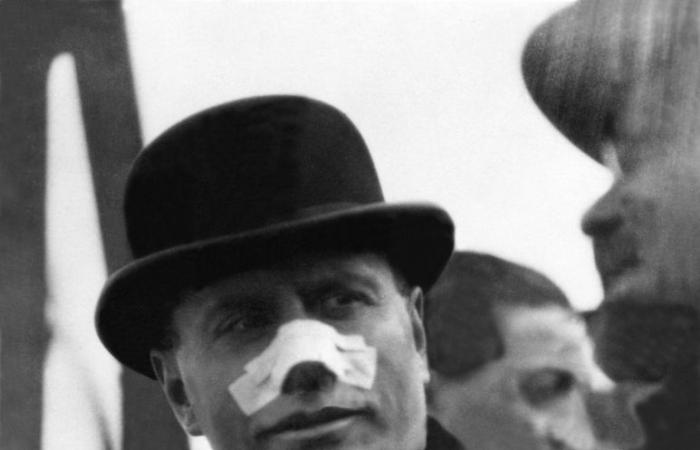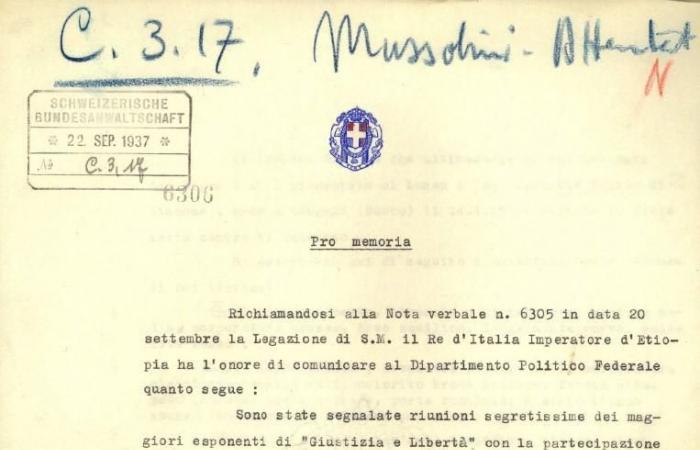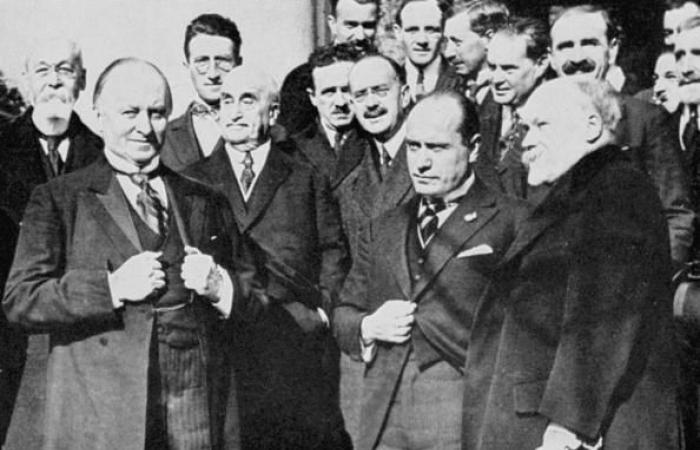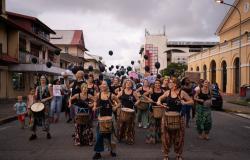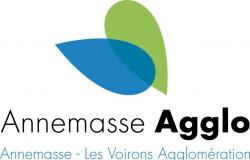The fascist years –
When Switzerland hunted down “the assassins” of Mussolini
For years, the Federal Prosecutor’s Office and the cantonal police meticulously investigated opponents reported by the fascist regime. Our investigation.
Published today at 08:54
In 1926, Mussolini escaped no fewer than three attacks in 1926. The Duce proudly displayed his injury, adopting the attitude of a survivor. These years will also be those of “extreme fascist laws”, which will lead to the repression of opponents and the institution of special courts. Switzerland is not going to escape this.
KEYSTONE
Subscribe now and enjoy the audio playback feature.
BotTalk
- The Swiss services systematically investigated the opponents denounced by the Italian regime.
- The Swiss workers’ opposition was considered excessively threatening by the Swiss authorities.
During his career, Benito Mussolini survived six known attempted attacks, the first dating back to 1926 from an unhinged Irish woman, after which the Duce will treat his appearances with a huge bandage on his nose. The most famous remains that of Bologna, the same year, when a young 15-year-old anarchist missed his target and was massacred by the crowd and the fascists.
The Duce will take the opportunity to proclaim the “fascist laws”, the texts, already planned, governing a now totalitarian, police regime, with a special court for state security. And, above all, by causing a real psychosis which will turn the slightest rumor into a plot aimed at overthrowing the nation.
Denunciations of the regime
What is less known is that for almost twenty years, justice and the Swiss police will somewhere in turn be attacked, by systematically tracking down potential opponents denounced by the fascist regime. This is what a file kept at the Federal Archives, unearthed by “24 Heures”, tells us.
In fact, Italian justice had had Swiss activists in its sights for a while. In 1927, Emil Hofmaier from Basel was arrested in Milan for “communist propaganda” and sentenced to 15 years in prison. The matter goes back to the Federal Council, which refuses to intervene.

1937, the Italian Consulate a series of anarchists and suspects. Under the cover of threats of attacks on the Duce or on diplomatic installations, the authorities of the regime will attract the attention of the federal prosecutor’s office or the cantonal police on opponents for years.
Swiss Federal Archives, E4320B#1974/47#134
Serious things began in March 1937 – year XV of the fascist era, year honorary doctorate received from the University of Lausannea year during which the Communist Party was banned in several Swiss cantons.
The Italian embassy then denounced five individuals, including known anarchists, who could attack their diplomatic organs. The Federal Public Prosecutor’s Office circulates the list and requests their immediate arrest if they appear at the border. One of them, Camillo Sartoris, was arrested in Belgium in 1938.
Also in 1937, the Italian embassy, undoubtedly informed by its local informants, asked to take all possible measures against a certain L. Bezzola: he allegedly assured, at the Café des Lauriers in Pontaise, that a “big blow against Mussolini” was being prepared among the Spanish anarchists.
Unions and violence
The Federal Public Prosecutor’s Office obviously has little faith in counter-reports, but takes the opportunity to interview the suspect. And for good reason, Bezzola, a communist and worker from Ticino, was already in the viewfinder ten years earlier. Not only did he not pay his pensions to a young woman from Bienne, but “he is an extremist, part of the plasterer-painter union” active in Lausanne.
A justified distrust? Worth seeing, according to Colin Rutschmann, historian who devoted his dissertation to anti-fascism in Lausanne during the interwar period. “At the time, Lausanne was a center of fascist propaganda in French-speaking Switzerland, their supporters were very visible but their actions were often thwarted by opponents, notably the Anti-Fascist Alliance, the Lausanne subsection of the Communist Party, the Socialist Workers’ Party. Lausanne and the FOBB: the Federation of Wood and Building Workers. It is a very important union, at a time when the working environment is permeated by expatriates and Italian refugees. In reaction to the fascist demonstrations, there are brawls, fights, we have a complaint of shooting… It is a phenomenon which is not anecdotal.
July, new alerts from the Italian legation, which denounced two anarchists, in Ticino and Geneva, while Hitler and Mussolini were to meet in person the following September. This time, the Prosecutor’s Office is more worried: an anonymous letter to the “Corriere della Sera» also announced an upcoming attack on Mussolini, on the part of a Ticino.

Anonymous threatening letter addressed to Mussolini from Geneva. The authors will not be found.
Swiss Federal Archives, E4320B#1974/47#134
The Zurich police were put on the spot, analyzed the letter and followed all leads. False alarm, the Ticino police will react in substance. One of the other suspects reported by Italy being none other than Rusconi, the vice-syndic of Bellinzona, beyond any suspicion… There is obviously confusion with another Rusconi, a real activist, based in Lausanne .
The hunt for a future war hero
The alert was, however, sent to all cantonal police, with orders to monitor “suspected anti-fascists” and arrest them if necessary. There follows a list of foreigners, anarchists, perhaps equipped with bombs, to be arrested at the border. The list had been sent the day before by the Italian embassy, which will regularly provide additional reports.
The Geneva police will carefully follow one of them, making trips and meetings between Annemasse and Geneva. Because he is certainly carrying out “secret and illegal activities”, the Attorney General of the Confederation requests searches and, if necessary, to arrest the individual. His name? Massimo Salvadori. Historian, future agent of the “Special Operations Executive”, a key link in the Italian resistance, he was decorated by England after the war.

Benito Mussolin during the Lausanne Conference in 1922.
Universal Images Group via Getty Images
The files follow one another quickly. In December 1937, the Italian consulate asked for clues about two Swiss communists, Ludwig Borer and Hellmuth Schrittmacher. A few days later, alert on a certain Angela Coldart from La Chaux-de-Fonds, who is preparing a mission for the Communist Party. Problem: none of these individuals exist or are known to the services. Either the fascist pipes are breached, or the suspects are real, but under the radar.
Moles among the anarchists
New case of anonymous letter at the beginning of 1938. The Geneva Police compared the writing of the letter to the file of known anarchists, and asked for advice from the Italian fascists established in the city. May 1938, new “extremely urgent” alerts from the legation. Four anti-fascists suspected of targeting Duce during his trip to Genoa are placed under surveillance. But if the police carry out the usual checks, one wonders if the Federal Prosecutor’s Office does not end up getting tired of the increasingly eccentric Italian information.
Anarchist networks nonetheless remain closely monitored, to the point of infiltrating them. October 1938, the group “Le Réveil” was the subject of a close report, warning of a planned attack which Luigi Bertoni and Lucien Tronchet discussed. Nothing less than figures of Swiss revolutionary trade unionism.

Luigi Bertoni (1872-1947) was an editor in several émigré newspapers published in Switzerland, then in anarchist titles. Figure of trade unionism, condemned several times, notably for having welcomed the death of Umberto I, in an article which led to a diplomatic crisis between Switzerland and Italy.
Franco Serantini Library
Italian denunciations of potential instigators of attacks are intensifying. No less than five in a few weeks, mostly Ticino or exiled Italians.
Protégé of Albert Londres
In 1938 and 1939, a new affair broke out. In Geneva, a poor forty-year-old, orphaned and rescued by sad lords, tries to end her life. To the inspectors, she denounces her lover, Robert Meylan, an anarchist who got along with no more and no less than Eugène Dieudonné. To the desperate woman, they would have given a weapon and designated the Duce, asking him to do something useful. What is the reality behind the drama? Mystery. What is certain is that Dieudonné was a celebrity at the time. A survivor of Bonnot’s gang, he made a name for himself by escaping from Cayenne and denouncing to the public the horror of the prisons.
The threats of attacks on Mussolini, however, continue to worry the Italian legation and the public prosecutor’s office. In March 1939, the Zurich police watched without much belief a certain Korrodi, a digger, communist and notorious braggart.
A disproportionate repressive arsenal
In the end, were these threats of attacks real? Probably not. What did indeed exist was a disproportionate reaction from the Swiss police. “We can clearly see, in Lausanne, that each deployment of opposition to the fascists brings with it a whole repressive arsenal,” reacts Colin Rutschmann. In 1932, for example, a bomb exploded in front of the Palud City Hall. The police will consider that this is a reaction to the shooting in Geneva and will take the opportunity to carry out a series of arrests and searches, asking in particular which party they were affiliated with.”
In September 1940, the outbreak of hostilities did not prevent the Italian consulate from launching a denunciation. It will be one of the last to appear in the archives, and not the least: a plot against the Duce takes place in Zurich, the head of the network being a certain Smith, quite simply the English vice-consul. The cantonal police will then begin a detailed decryption of movements in buildings and consular accommodation, trying to cross-reference identities with proven or known spies. Without much success.
“Latest news”
Want to stay on top of the news? “24 Heures” offers you two appointments per day, directly in your email box. So you don’t miss anything that’s happening in your Canton, in Switzerland or around the world.
Other newsletters
Log in
Did you find an error? Please report it to us.
1 comment


